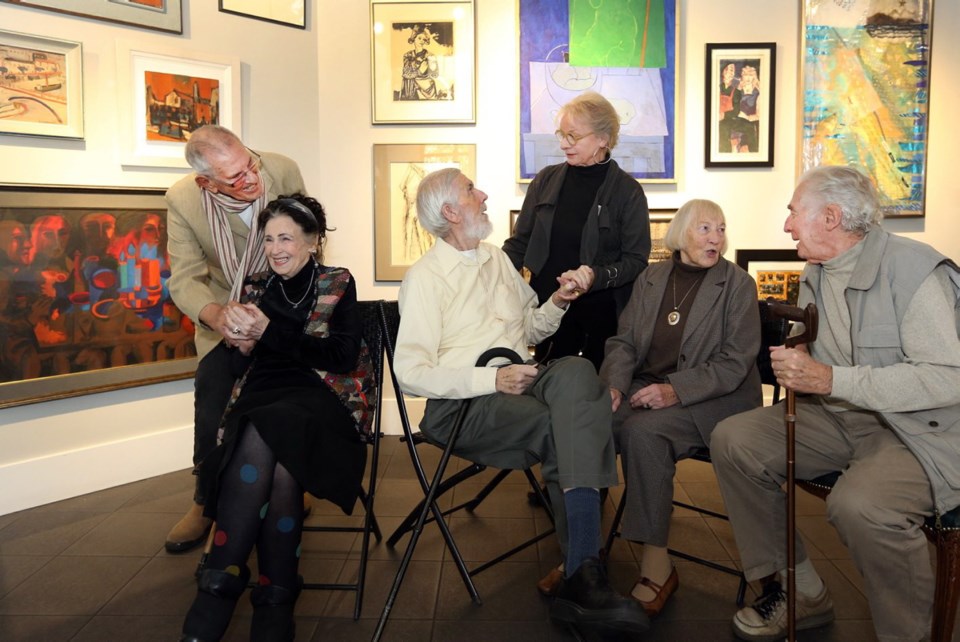What: Limners: A Victoria Legacy
When: Opening Saturday, 2 to 4 p.m. Continues to Nov. 16
Where: Winchester Galleries, 796 Humboldt St.
Karl Spreitz and Pat Martin Bates greet each other with a strong hug, a peck on the mouth and a swordfight with their canes as they cross the threshold of the Winchester Gallery.
“We are the two remaining original Limners,” Spreitz says with his arm around Bates’s small shoulder.
Together with Walter Dexter, Helga and Jan Grove, and Carole Sabiston, who greet each other warmly as they filter into the gallery, they are the surviving members of an artists’ collective formed in 1971 that once counted 17 official members and even more honorary ones. While most have died and the collective officially disbanded in 2008, these Limners are preparing for a momentous occasion — a group show dedicated to their work and legacy.
In addition to those already mentioned, members included Maxwell Bates, Richard Ciccimarra, Robert De Castro, Nita Forrest, Colin Graham, Leroy Jensen, Elza Mayhew, Myfanwy Pavelic, Nikola Pavelic, Herbert Siebner, Robin Skelton, Sylvia Skelton and Jack Wilkinson.
As the community’s senior artists in the 1970s and 1980s, the Limners are regularly credited with encouraging the development of a more progressive local art scene.
“The legacy that the Limners left has to do with a new movement of new ideas and individual, unique perceptions of what art is,” Bates said this week.
And while they worked independently and built their own careers, reaching different heights before and after their time as the Limners — from Pavelic’s official portrait of Pierre Trudeau to Mayhew’s representation of Canada at the 1964 Venice Biennale — the support they gathered from the collective wasn’t superficial. “There were other people who were totally ignored in Victoria, who did contemporary work, but they didn’t have the backing,” Bates said.
Attitudes toward modern art, which was already wrapping up its heyday in other parts of the world by the 1970s, were absent from the fledgling arts scene in Victoria, according to Bates. “It was non-existent,” Bates said. “I think there were very few people who recognized anything the least bit modern.”
However, the city may have only needed some initiative. Helga Grove said she and her husband Jan were told their first pottery exhibition at the Art Gallery of Greater Victoria wouldn’t draw an audience. It was so out of the realm of what Victoria was used to that the gallery didn’t even have the proper infrastructure for displaying the work; they improvised pedestals using concrete blocks and plywood. But the audience proved them wrong.
“Everyone was saying, ‘Oh, it will probably not go over well,’ ” Helga said. “But it was packed. Victoria was ready.”
For the most part, Victoria had been dedicated to representations of flowers, landscapes, ships and ocean views. The Limners, by contrast, were united by humanism, according to Pat Bovey, former director of the AGGV.
“The common element of their work is the human figure, or the human condition,” Bovey wrote in A Passion for Art, her book dedicated to the Limners.
The Limners never declared an official manifesto. Working independently in varied media — from painting to textile art, pottery and film — they’d gather to create a supportive network. “We really didn’t talk art principles, it was just this understanding and respect,” said Sabiston.
That’s not to say that they didn’t share a common bond in art, too. “We cared about one another, yes. But we also cared about the way that everyone was working, the kind of work they were producing, the quality of it,” Bates said.
Among the things the Limners brought to Victoria was a shared global perspective. While some members were native to the city, many came from Europe following the Second World War. They carried with them more progressive ideas about art and an international perspective that provided a basis for friendship. “That forged a very strong bond between us all,” Helga Grove said.
Each was drawn to Victoria for a different reason, but all were affected by the isolation. “It was hard to get across the water to Vancouver. But it was also hard to get over the bloody mountains. It still is,” Dexter said. “To my students, I always say, ‘Go to Toronto or New York if you’re really ambitious.’ ”
But asked what kept them here, each said, almost in unison, “Victoria.” It seemed the perfect combination of natural beauty and community.
Their age may prohibit most from creating works these days, but the thing that bonded them is obviously still strong — support, respect and love.
Gathered around a table to talk about their shared history, conversation feels more like a dinner party than an interview — filled with recollections of Herbert Siebner’s “party trick” of wrapping himself in toilet paper and setting it alight, extravagant plans for international group shows that didn’t pan out, and the way that the last person to arrive at each AGM had to assume the role of president.
Reflecting on the Victoria arts scene today, they say attitudes toward art are still generally conservative. But there have been improvements: more exhibition space, a better understanding of technique and more galleries with established reputation.
Now that they’re watching the Winchester show go up, in the same week that a show dedicated to the Limners opens in Calgary’s Wallace Gallery, it seems the Island won’t isolate their legacy. It’s bolstered by the addition of their society’s materials to the University of Victoria’s archives as well as the way their works are scattered throughout collections locally, nationally and internationally.
“I think we may have focused or helped the art community here, just by the fact that we got together,” Dexter said.
“And we’re still here and we’re being talked about. And I think that helps the whole community.”
